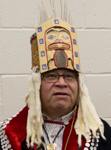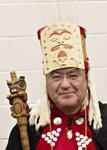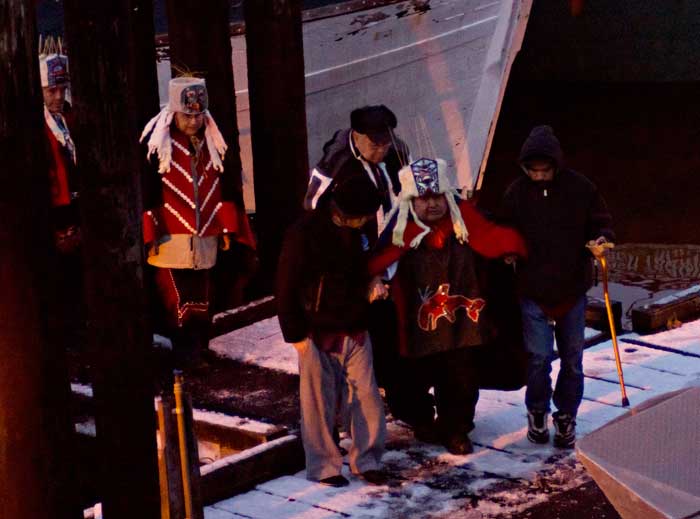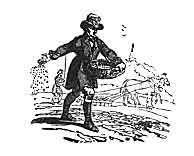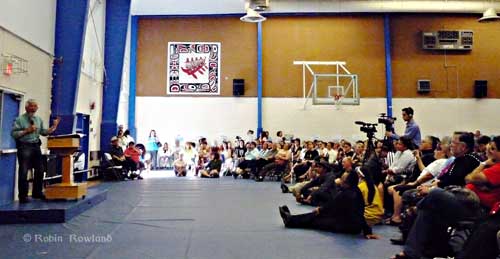This story presents the unfiltered voices of Haisla chiefs when they testified at the Northern Gateway Pipeline Joint Review hearings on January 10, 2011, at Kitamaat Village, based on the official transcript. There have been minor edits for clarity.

Thank you. My name is Ken Hall. I’m from Kemano, the Kitlope area. My father was there and my mother was from Kitamaat. And I was born in Kitamaat and raised partially in Kitamaat and Butedale where my father worked.
As I grew up in Butedale and coming in here in between seasons, as I
grew up with my brothers and sisters, I was taught many of the things that we need to do in order to be a good member of the Haisla Nation. And I was told never to look down on other people that are walking around, even if you’re a chief or not, and be nice to one another.
This has always been expressed to us as I was growing up. I was adopted by my late father as a young man into the Eagle Tribe. I grew up in this tribe and he adopted me, and that was unexpected from my side of the view, and I was wondering why that happened. But he never expressed anything to the people as to why he had done that until later on.
In our system, as you heard my Chief speak about it, that we were taught and had to be well-knowledged by our traditional system and be respectful and show good leadership. So with that, my name is Tequicah , a Chief for the Eagle Tribe in the Kitlope, Kemano area. And this name that I carry is the steward of the Saint Mathews Bay which is a big bass area up in Gardner Canal towards Kitlope.
And this has always been the system that each chief has a place where they can hunt or fish or trap. Not only my family can do that, but anybody can go in there in this community. And in doing so, they acknowledge us.
But nevertheless, I learned a lot through my relatives, cousins, uncles, grandpa, all the traditional things that they spoke of. And how to be able to survive in our territory was the main thing that they taught us, how to be a provider, how to have respect for animals and things like that.
We don’t just shoot them for spite. We take them for our needs of our family. In doing so, we acknowledge each animal as we kill it for what we learned is that they have a great spirit too. And we tell them and we say, “Nollo, nollo” to them. That’s a way of praising them and apologizing to them for what we’ve done to them. “We didn’t do any harm to you. We’ve done this because our families are in need.”
And the main thing that was taught to me was to be conservative in every way. As you’ve heard the others speak before me that you can’t take too much of what you gather, whether you’re hunting, fishing or picking berries; always get enough that you can preserve or conserve it or leave the rest for others that are in need.
My father’s name was Simon Hall. He was from Kemano, Kitlope area and my mother’s name was Amelia Duncan, then Hall, was born in Kitamaat Village. My father was a Chief of the Eagle Clan also and he taught me many things about hunting and shooting and fishing in my time as I was growing up.
And without anything said to me or warning of what’s going to happen, he adopted me to the Eagle Clan, but later on told me, as he went into another phase — he installed what is called in line of a chief, Henaaksiala. He gave it to me and he told the people then that I was, in his view, good enough to be one that can represent or talk to my family, brothers and sisters in my own family.
I was called one time as I worked for the council. I operated a passenger boat. I came in from Kitlope and while we were preparing camp, I was reading a story that we had. I got back from Kitlope about 10:30 in the morning. I got into the house and my wife told me “There’s a lady that wants to talk to talk to you from high school.”
So she showed me that number and I phoned her right away, and she asked me “Can you come over and make another presentation to the high school teachers? There’s about 40 here that’s anxious to hear you speak the stories of your life and legends and what have you been taught. They’d like to learn that.”
The main thing about that was respect. The very first thing that was taught to me was respect. My father and grandfather often told me, “If you don’t have any respect for yourself, nobody will respect you.”
Anyway, when I arrived in the high school, there was 40 kids — high school kids — in the room waiting for me and they welcomed me. And I told Sharon, the people who was organizing everything, that I wasn’t prepared for anything such as this today. So what I’m going to do, it might prompt me up with something that I know. I’ll have a question period there for a few minutes.
Right away, four hands went up. And I started going one at a time to them, asking them what they wanted to say. And the fourth one was a young girl. I asked her what she wanted to say, if she had any concern, and she said, “What I want to know is how long was Alcan here before you people moved in?”
I sort of chuckled and I told her we’ve been here for thousands of years before Alcan ever seen this place. And she couldn’t believe it. She figured that Alcan let us in here.
But we’ve got stories from way, way back as the area being burned, what you see up there in the valley, as you heard my chief speak, that the trees where small from way back.
But anyway, I spoke of many things of my past experience to them. And I grew up in a place called Butedale. It’s about 70 miles from here. There’s a cannery, reduction plant and a cold storage, where my father was employed as a captain on a boat, his boat.
He had his own sailboat, and I went on it with him as a young boy, just riding around with him and watching the people. He had seven people who was on with him, helping him retrieve the net when he sets it, working all day. Their day starts at 4 o’clock in the morning. Sometimes they go to bed at 12:00 at night. This is what I learned from my father.
He often told us many things about when you are hunting, fishing, or whatever you’re doing, you need to be really on the line of moving right now, not later. Otherwise, you’ll never get anything.
But anyway, after saying that I fished salmon with my father, and as a young man, I grew up with him on a fishing boat. For 18 years I was a crew member with him, both halibut, herring and salmon. And it’s a lot of work, but I enjoyed learning all of the — but when coming home, when we come home in between fishing season, we go to the river, either Kitimat River, Kemano or Kitasoo to fish eulachons.
These are the things that they taught me, how to gather all the food that we need to serve to my family for all year, to preserve it. My wife knows how to preserve just about anything that we get. Now the freezer has come; we freeze a lot of them.
When we fished eulachons, it was always “Be careful. Don’t be careless. Don’t dump anything in the water. You’ve got to make sure this river is pure at all times, never contaminated with garbage or anything. Always make sure that the eulachons will come back for the next generation to come, salmon, what have you, water hog.”
And they used to go gather the roots and everything along the flats, my mother, my grandmother. That was a real staple for everybody, all of the things that we gathered. It was so nice to see it on the table when it was fresh, when we’d first kill it and they’d praise us and thank — are very thankful to us.
When I came home from fishing, I was approached if I could run for a council member by four guys in the village. When I did get in, which I failed the first time — I did get in and I stayed in there for over 20 years and I was the Chief Councillor from 1999 to 2001 for Kitamaat Village. And that’s a lot of work. Most of the time is spent on trying to keep our territory as clean as possible, because we had everything coming from all directions, wanting to use it.
I used to hunt and fish around Kitlope and Kemano area, as well as Douglas Channel area, and getting to know some other people along the line from different villages and we worked together on it at all times.
I still fish for our own use right now, even though I’m retired. Just like Rod said, we need to go out and teach our younger people, which I do. I’m proud to say that my nephews and my granddaughter are there to help us when we do bring some things in. Some of it they have learned from their grandmother, all of the things that were handed down to us from our forefathers.
When possible, I fish for eulachons, but I haven’t done that for the last several years due to the fact that they don’t repair in our rivers anymore. And it’s sad to know a source gone from your table, but it’s happy to know that other First Nations are there to care for you, to work together to give us eulachons when they get their eulachons.
My wife has been buying eulachon grease from other places. And I don’t know what we’d do without it. We certainly can’t use crude oil anyway.
I’m totally dependent on seafood too. In my days of growing up, we had everything from clams, cockles, crabs, shrimps and mussels, as well as halibut, red cod and different types of cods that we’d catch out there, which is slowly diminishing again. As a matter of fact, it is — it will be gone in time if we don’t stop it.
This is where our frustration comes in, with supposedly our government looking after us, promising to look after us, but which never did happen.
I heard some stories from when I was young, and I was taught to follow our Nuyem, which is the law of the Haisla Nation as well as all the First Nations that are listening today. They gather this and they keep it and pass it on to one another, one of the younger ones and all that, the next-door Nations that comes from. They make sure they learn it.
They don’t just tell it once; they keep repeating it after another. And that’s what happened to me to make sure that I keep away from danger, causing any harm to anybody, not injuring anybody, in fact, learning how to get along together.
When I became a Chief, my father lectured me. “Now that you carry a big name, from Hamatichi-sa, I don’t know if the Haisla will recognize it, and I want to mention it to late Tommy Robinson in a meeting what my dad told me and right away he rejected that idea that — he said you guys are strong, we strongly recognize you as a chief of the Kitasoo people.
Kitasoo people, as a matter of fact, amalgamated with the Haisla back in — I think it was 1948 when they signed the agreement after years of — a few years of negotiations. Kitasoo was a big place at one time but due to influenza and — that was smallpox I think, done away with a lot of them, right down to about 68 by the time they were accepted there.
But we are the survivors, same thing with the Haisla’s; there’s a lot of them that went on that due to that sickness that was brought over. I don’t know where it came from but people were falling all over the place as they were talking. When a sickness got into them they just drop, that’s how fast they were dying.
One thing that I appreciate though is that we get medications for that now. They say that same sickness is the one that killed our people a long time ago, what
we’re putting up with today.
My nephews, who I work together and taught as a young man are the ones that are responsible for bringing us food now in my house, as I’m 74 now but I enjoy going out there yet. When the time is right I go out with them. And a lot of them in this community, young people are doing the same thing for their parents — being taught by their parents and grandparents how to fish, hunt and whatever their requirements are.
I heard many stories from a lady that died at a very old age, from Kemano, regarding how our people work together in the area. And I thought of — I talked to the person that came amongst us and became a new medium, he kept telling my people before my time — before our time that the animals and the fish and what have you, the birds looked like human beings when I talk to them.
She was the one that knew what happened with the eulachon in that river a long time ago. And she was the one that told the people to look for that eulachon that
was lost and they belonged to the leaders of the eulachon, the chief of the eulachons.
When they found it they made her told that the eulachon came up the river and they — next day that thing was just loaded with eulachons. This is why we make sure we learn and keep what they taught us, how to treat ourselves or treat the animals that we get; never say anything bad about the animals when you do shoot them, otherwise they’ll get you back. That’s what we were told.
Even the fish too. When we get an animal, when we get up to it we say “Nola, nola, nola”( ph). That’s thanking the spirit — his spirit for allowing us to take the animal to feed our family. We tell him we don’t — we’re not doing this for spite, we’re seriously taking it to feed our family so they can be healthy and we thank you for it.
These are the things we are told to follow at all times and I wish it could be told to everybody regarding our territory, what’s going on. As we mentioned earlier, and the other Chief mentioned, that everything is slowly going down, getting less and less every time we go out to try and gather. You have everything on the — out there that — gathering the things and they’re not commercially getting — they’re just playing around with them.
I know everyone tells me to be careful with the land and resources and make sure that it’s clean. I need to repeat that, that’s what’s aiming at the Haisla Nation regarding our territory, our land.
I spent eight years in the council, along with other councillors, fighting to save a territory that was aimed by a logger — a logging outfit. It took us eight years to fight for it. We made it but it was a long hard work. The part I couldn’t understand about it, when we did get it preserved we weren’t given any money to help patrol it, yet we’re part of that area, and that’s Kitlope.
It took us eight years to fight for it in a council and as well as a community, not just a council, everybody in the community supported the council and they stood side-by-side right through. And most of the time I was away from home joining meetings. I was happy when they signed the agreement but I was really tired. I’m glad that I was part of it to see that happen for the future of my grandchildren and great grandchildren is what I’m talking about.
Again, you mention grandchildren, I’m here to speak in my share of our territory which is pipeline coming down our territory and also big ships navigating Douglas Channel. I clearly state in my community that the Haisla’s are facing a double-barrel gun — shotgun — if you bring those oil in by land, as well as navigating Douglas Channel. One spill from both of them will wipe out everything that we have, what we mentioned here; you’ll have no more.
Why I mentioned all that stuff that we gather, as you all know, during the hungry ‘30’s they call it, I often heard my Elders — we didn’t even know that the world was hungry, we were so rich in resources in our territory, we were never hungry, we were always eating, yet, other parts of the world were hungry because of the depression.
Again it saddens me to know that we’ll be joining that if anything happens to our territory here regarding that oil and the pipeline.
It brings into mind of what we told if you’re careless, you’re not going to get anything anymore. It’s not going to be us that’s going to suffer; like what I said it’s going to be our grandchildren. And the people that done the damage will just put their hands in their pockets and walk away, like Eurocan done to us. They polluted our river and they said enough is enough and they just walked away, never looking back.
It just terrifies me to know that we’re even facing about destruction with what’s coming before us, the Haisla Nation.
It’s very important that — I’m glad some of the young people are showing up here and they’re listening, I believe, by internet, as to what’s going on here and I strongly urge that, that they listen and take notes of what’s going on here, it’s their future why we’re here, you see the panel here, it’s their future while we’re sitting in front of you here, to let you know our concern.
As I told you before, the Haislas were taught how to conserve and preserve everything they get. I operated a boat for a rediscovery camp, which was a very powerful thing to do in teaching our young people our traditional system, not only for Haislas, but other First Nations as well as other countries, Sweden, Norway and I can’t remember the others, anyway, but — from Thailand. They all came down the States. Young people came.
They spent a whole month in the catch hole with us, some of them half a month because we taught them everything about how to dry fish, how to can fish and things like that. Pick berries; how to preserve it, how to use it, and the things that we used to eat.
Grease wasn’t the only thing that we ate with fish, but it came — it was good with everything that we had on a table at that time because we never used to get butter or anything like that, lard. It was used for making bread. It was used for boiling fish, everything. It was a good flavour for anything that you wanted to put it in.
Now we’re pretty scarce on that part due to eulachons are not here. And why I mention that, it’s going to be terrible, terrifying if everything disappears on us in our territory.
My father had a sailboat, as I mentioned, as a young boy. I’d like to go back to that and be out there. He used — he got a contract when Alcan first came to tow barge loads of groceries from freights from Butedale to Kemano, which wasn’t accessed by those big freighters. There was no docks there, just the skull grid.
And one weekend — one Friday afternoon, I was in time for him to come out of school and I asked if I could go along with him. It was a real beautiful morning when we got into Kemano Bay with our barge. As soon as you got in, they started to unload it. And my father was standing there and he was scratching his head, took his cap off and started scratching his head. And he said in our language this is what he seen then, this is what he was talking about.
And I asked him, “What are you talking about, Dad?” He said, “Your grandfather,” he said, “he had a premonition after encountering a Sasqua.” He had a spirit that went into him and he was able to foresee the future. He said he told the people — he called the people in Kemano and told them there’s going to be a big monster coming up on Kemano Bay and it’s going to go right up along that river. It’s going to go — he named that mountain. It’s going to go there and it’s going to bore a hole through there.
That was about 50 years after he died, then, it happened; almost 50 years, anyway. And that’s what dad was talking about when he said — this is what he was talking about then.
And it’s so true that there’s a lot of difference from that day on.
Everything started going down, which we thought was a better thing for us. It actually goes against our ability to gather the things we needed for our house.
I operated a tugboat. I worked for Redtow for three and a half years. I got laid off due to the fact that there was a cutback, five years and under, and I was 15 months short of my five years, so I voluntarily — they wanted to get me on as a deckhand, but I just told them I’m going home. That was when everything started going down after Eurocan started. I was working there all the time; they were bringing the material for Eurocan.
And right away, I noticed when the pulp mill started that it had a detrimental effect on the river, for they never dumped their effluent until night, and it was a horrible sight. It was higher than the deck of a tugboat, if you know how a tugboat looks like. The foam that was there coming down the river was higher than the tugboat I was operating on the back deck, and it smelled awful. My crew couldn’t stay on deck very long due to the bad smell of that effluent.
And when we complained about it, Eurocan told us — the President came to a public meeting at the old hall and told us, “Don’t worry about it. It’s not going to harm you any. There’s no poison in it.”
It’s sad to say, but a lot of my people that continued — that listened to him kept on eating that fish and they — most of them died with stomach cancer and different types of sickness came around just because that guy said it was safe to drink it.
Our Chief Councillor at that time challenged him, “I’ll go upriver with you, bring a cup. You drink one cup; I’ll drink one cup, too.” He wouldn’t make a move. We tried to beg him to go up there.
And I told my mother, “I don’t think you should eat that. It smells awful.” And my father spoke up, “Didn’t you hear that man spoke in the hall? He said it’s safe.” But I — we wouldn’t touch it anyway.
It was terrible, and it’s a bad experience way to learn how bad that thing is.
And just imagine what my grandchildren will go through if this happens, what’s coming before us.
I was one that witnessed the — like what I said, the impact of Alcan and Eurocan to our territory. It’s been devastating, really, to the fact that when Alcan first came around I was just a young boy. I remember that public meeting that they went to up in the oval hall.
That public meeting, one of the councillors got up and asked the Indian agency, “What are you doing over there? You’re sitting with an Alcan representative. You’re supposed to be sitting with us.” The councillor could not care less. They weren’t allowed to have a lawyer to represent them. In fact, Alcan proposed that they have their smelter set right here, right where we’re sitting, but it was too small for their liking, so they moved, which was a good thing in a small part. They moved over there where they’re at right now, where Rod’s trap line is.
Again, the question is, why weren’t we allowed to have a lawyer represent us? Just because we weren’t educated enough or something? I don’t know.
But anyway, in doing so, I was really sad, like what I said, at what’s going on, so as the other communities that are with me here today, the Bella Bella people. They’re here today to be with us. Kitasoo/Xaixais are here. Kitkaa are here, along with other First Nations. They’re here to support the Haislas in standing with them side by side. They want to stand in solidarity to show their support towards the Haisla Nations.
Thank you.
